Healthcare Delivery in the USA: Federal Regulations and Nursing Roles
VerifiedAdded on 2022/11/25
|6
|1605
|67
Report
AI Summary
This report provides a comprehensive analysis of healthcare delivery in the United States, focusing on the impact of federal regulations, such as the Affordable Care Act, on nursing practice. It explores how quality measures and pay-for-performance models influence patient outcomes and details the evolving roles of nurses in ensuring patient safety and satisfaction. The report highlights emerging trends like telehealth and artificial intelligence, predicting their influence on nursing roles in the coming years. The study emphasizes the importance of professional nursing leadership and management in adapting to these changes and promoting quality care across diverse healthcare settings. The paper also examines the effect of nursing practice and the nurse's role and responsibility. The report also delves into the effect of quality measures and pay for performance on patient outcomes. The paper also explores the professional nursing leadership and management roles that have arisen, and how they are important in responding to emerging trends and in the promotion of patient safety and quality care in diverse health care settings. Finally, the report predicts the practice of nursing and nursing roles will grow or transform within the next five years to respond to upcoming trends or predicted issues in health care.
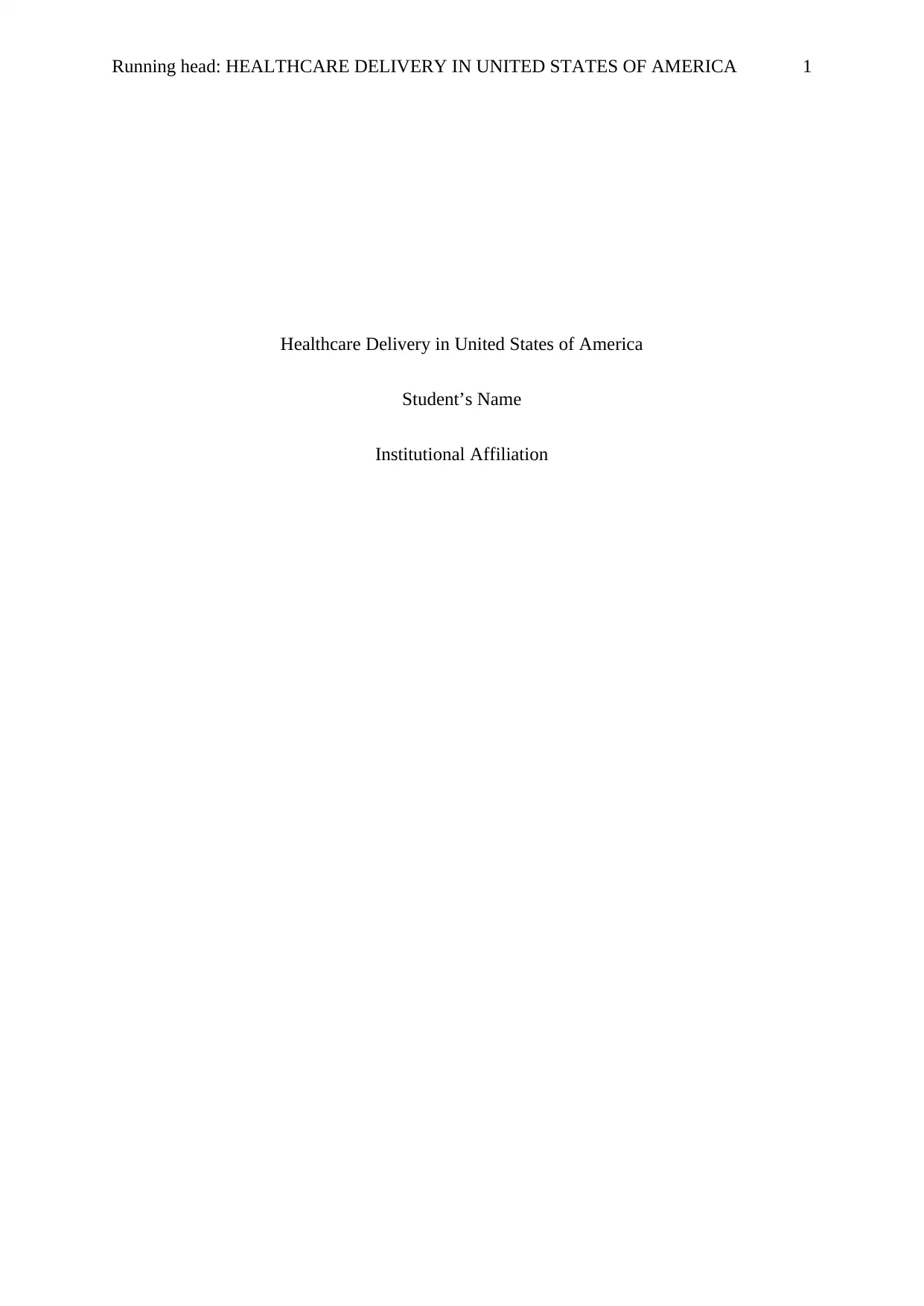
Running head: HEALTHCARE DELIVERY IN UNITED STATES OF AMERICA 1
Healthcare Delivery in United States of America
Student’s Name
Institutional Affiliation
Healthcare Delivery in United States of America
Student’s Name
Institutional Affiliation
Paraphrase This Document
Need a fresh take? Get an instant paraphrase of this document with our AI Paraphraser
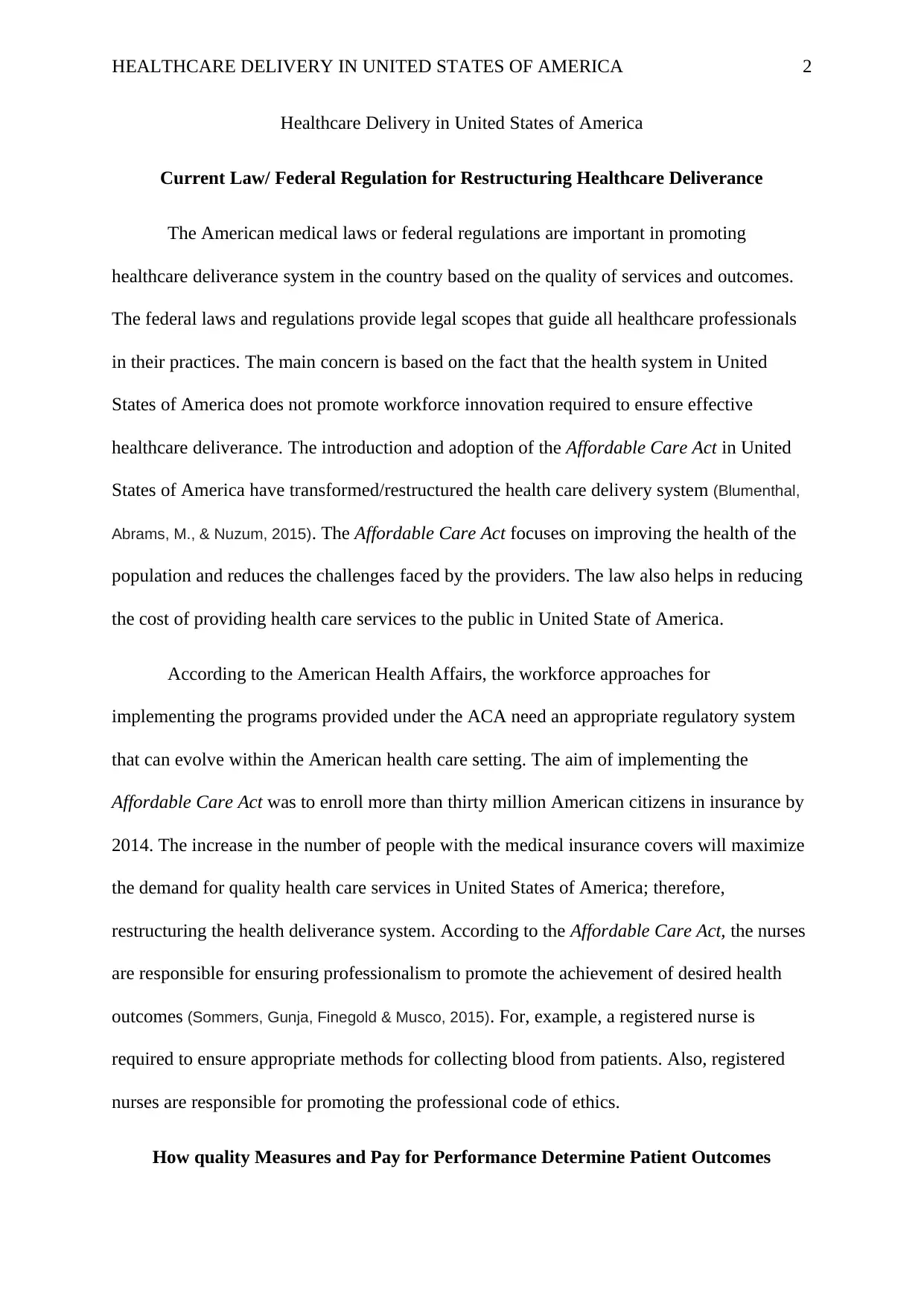
HEALTHCARE DELIVERY IN UNITED STATES OF AMERICA 2
Healthcare Delivery in United States of America
Current Law/ Federal Regulation for Restructuring Healthcare Deliverance
The American medical laws or federal regulations are important in promoting
healthcare deliverance system in the country based on the quality of services and outcomes.
The federal laws and regulations provide legal scopes that guide all healthcare professionals
in their practices. The main concern is based on the fact that the health system in United
States of America does not promote workforce innovation required to ensure effective
healthcare deliverance. The introduction and adoption of the Affordable Care Act in United
States of America have transformed/restructured the health care delivery system (Blumenthal,
Abrams, M., & Nuzum, 2015). The Affordable Care Act focuses on improving the health of the
population and reduces the challenges faced by the providers. The law also helps in reducing
the cost of providing health care services to the public in United State of America.
According to the American Health Affairs, the workforce approaches for
implementing the programs provided under the ACA need an appropriate regulatory system
that can evolve within the American health care setting. The aim of implementing the
Affordable Care Act was to enroll more than thirty million American citizens in insurance by
2014. The increase in the number of people with the medical insurance covers will maximize
the demand for quality health care services in United States of America; therefore,
restructuring the health deliverance system. According to the Affordable Care Act, the nurses
are responsible for ensuring professionalism to promote the achievement of desired health
outcomes (Sommers, Gunja, Finegold & Musco, 2015). For, example, a registered nurse is
required to ensure appropriate methods for collecting blood from patients. Also, registered
nurses are responsible for promoting the professional code of ethics.
How quality Measures and Pay for Performance Determine Patient Outcomes
Healthcare Delivery in United States of America
Current Law/ Federal Regulation for Restructuring Healthcare Deliverance
The American medical laws or federal regulations are important in promoting
healthcare deliverance system in the country based on the quality of services and outcomes.
The federal laws and regulations provide legal scopes that guide all healthcare professionals
in their practices. The main concern is based on the fact that the health system in United
States of America does not promote workforce innovation required to ensure effective
healthcare deliverance. The introduction and adoption of the Affordable Care Act in United
States of America have transformed/restructured the health care delivery system (Blumenthal,
Abrams, M., & Nuzum, 2015). The Affordable Care Act focuses on improving the health of the
population and reduces the challenges faced by the providers. The law also helps in reducing
the cost of providing health care services to the public in United State of America.
According to the American Health Affairs, the workforce approaches for
implementing the programs provided under the ACA need an appropriate regulatory system
that can evolve within the American health care setting. The aim of implementing the
Affordable Care Act was to enroll more than thirty million American citizens in insurance by
2014. The increase in the number of people with the medical insurance covers will maximize
the demand for quality health care services in United States of America; therefore,
restructuring the health deliverance system. According to the Affordable Care Act, the nurses
are responsible for ensuring professionalism to promote the achievement of desired health
outcomes (Sommers, Gunja, Finegold & Musco, 2015). For, example, a registered nurse is
required to ensure appropriate methods for collecting blood from patients. Also, registered
nurses are responsible for promoting the professional code of ethics.
How quality Measures and Pay for Performance Determine Patient Outcomes
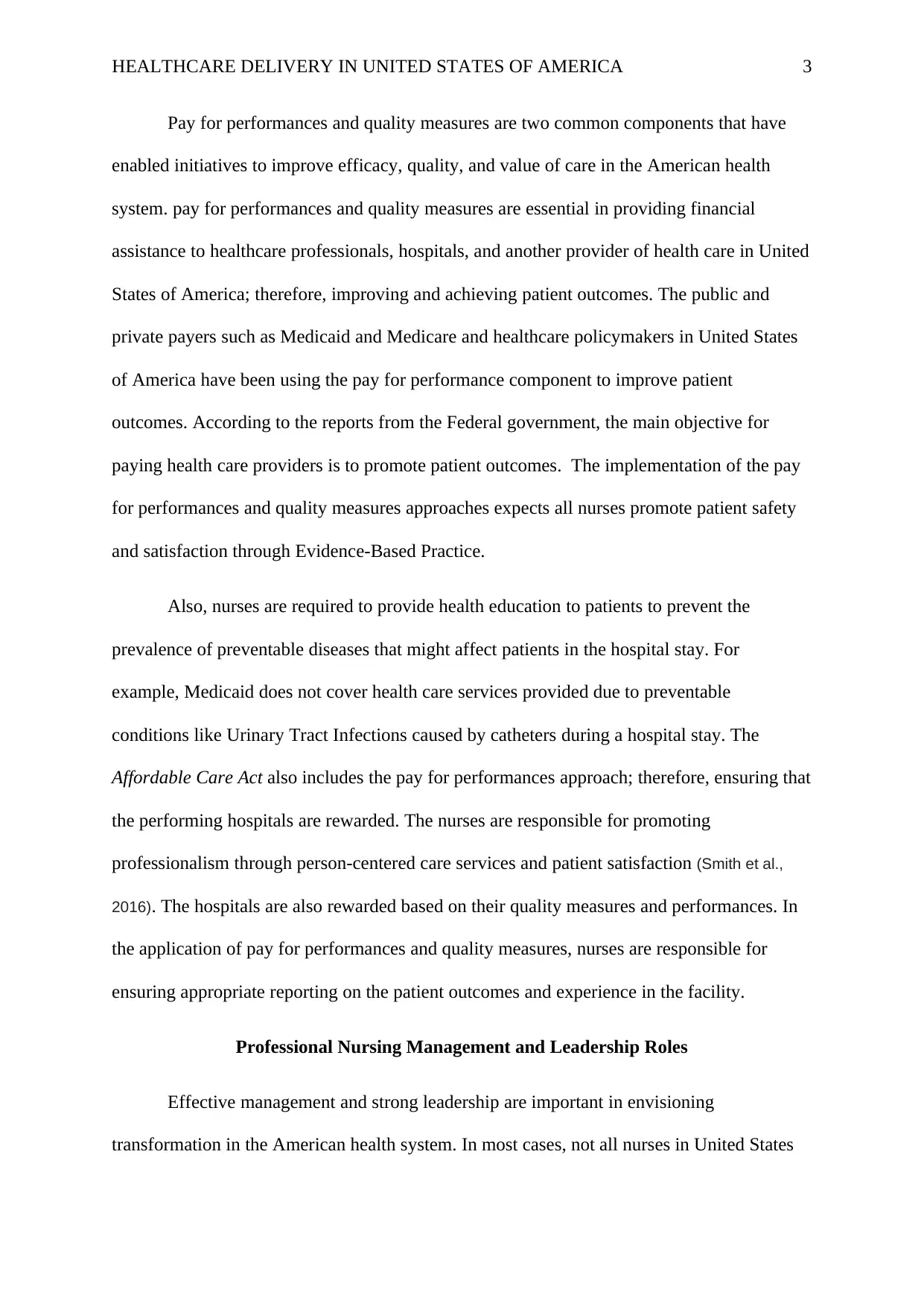
HEALTHCARE DELIVERY IN UNITED STATES OF AMERICA 3
Pay for performances and quality measures are two common components that have
enabled initiatives to improve efficacy, quality, and value of care in the American health
system. pay for performances and quality measures are essential in providing financial
assistance to healthcare professionals, hospitals, and another provider of health care in United
States of America; therefore, improving and achieving patient outcomes. The public and
private payers such as Medicaid and Medicare and healthcare policymakers in United States
of America have been using the pay for performance component to improve patient
outcomes. According to the reports from the Federal government, the main objective for
paying health care providers is to promote patient outcomes. The implementation of the pay
for performances and quality measures approaches expects all nurses promote patient safety
and satisfaction through Evidence-Based Practice.
Also, nurses are required to provide health education to patients to prevent the
prevalence of preventable diseases that might affect patients in the hospital stay. For
example, Medicaid does not cover health care services provided due to preventable
conditions like Urinary Tract Infections caused by catheters during a hospital stay. The
Affordable Care Act also includes the pay for performances approach; therefore, ensuring that
the performing hospitals are rewarded. The nurses are responsible for promoting
professionalism through person-centered care services and patient satisfaction (Smith et al.,
2016). The hospitals are also rewarded based on their quality measures and performances. In
the application of pay for performances and quality measures, nurses are responsible for
ensuring appropriate reporting on the patient outcomes and experience in the facility.
Professional Nursing Management and Leadership Roles
Effective management and strong leadership are important in envisioning
transformation in the American health system. In most cases, not all nurses in United States
Pay for performances and quality measures are two common components that have
enabled initiatives to improve efficacy, quality, and value of care in the American health
system. pay for performances and quality measures are essential in providing financial
assistance to healthcare professionals, hospitals, and another provider of health care in United
States of America; therefore, improving and achieving patient outcomes. The public and
private payers such as Medicaid and Medicare and healthcare policymakers in United States
of America have been using the pay for performance component to improve patient
outcomes. According to the reports from the Federal government, the main objective for
paying health care providers is to promote patient outcomes. The implementation of the pay
for performances and quality measures approaches expects all nurses promote patient safety
and satisfaction through Evidence-Based Practice.
Also, nurses are required to provide health education to patients to prevent the
prevalence of preventable diseases that might affect patients in the hospital stay. For
example, Medicaid does not cover health care services provided due to preventable
conditions like Urinary Tract Infections caused by catheters during a hospital stay. The
Affordable Care Act also includes the pay for performances approach; therefore, ensuring that
the performing hospitals are rewarded. The nurses are responsible for promoting
professionalism through person-centered care services and patient satisfaction (Smith et al.,
2016). The hospitals are also rewarded based on their quality measures and performances. In
the application of pay for performances and quality measures, nurses are responsible for
ensuring appropriate reporting on the patient outcomes and experience in the facility.
Professional Nursing Management and Leadership Roles
Effective management and strong leadership are important in envisioning
transformation in the American health system. In most cases, not all nurses in United States
⊘ This is a preview!⊘
Do you want full access?
Subscribe today to unlock all pages.

Trusted by 1+ million students worldwide
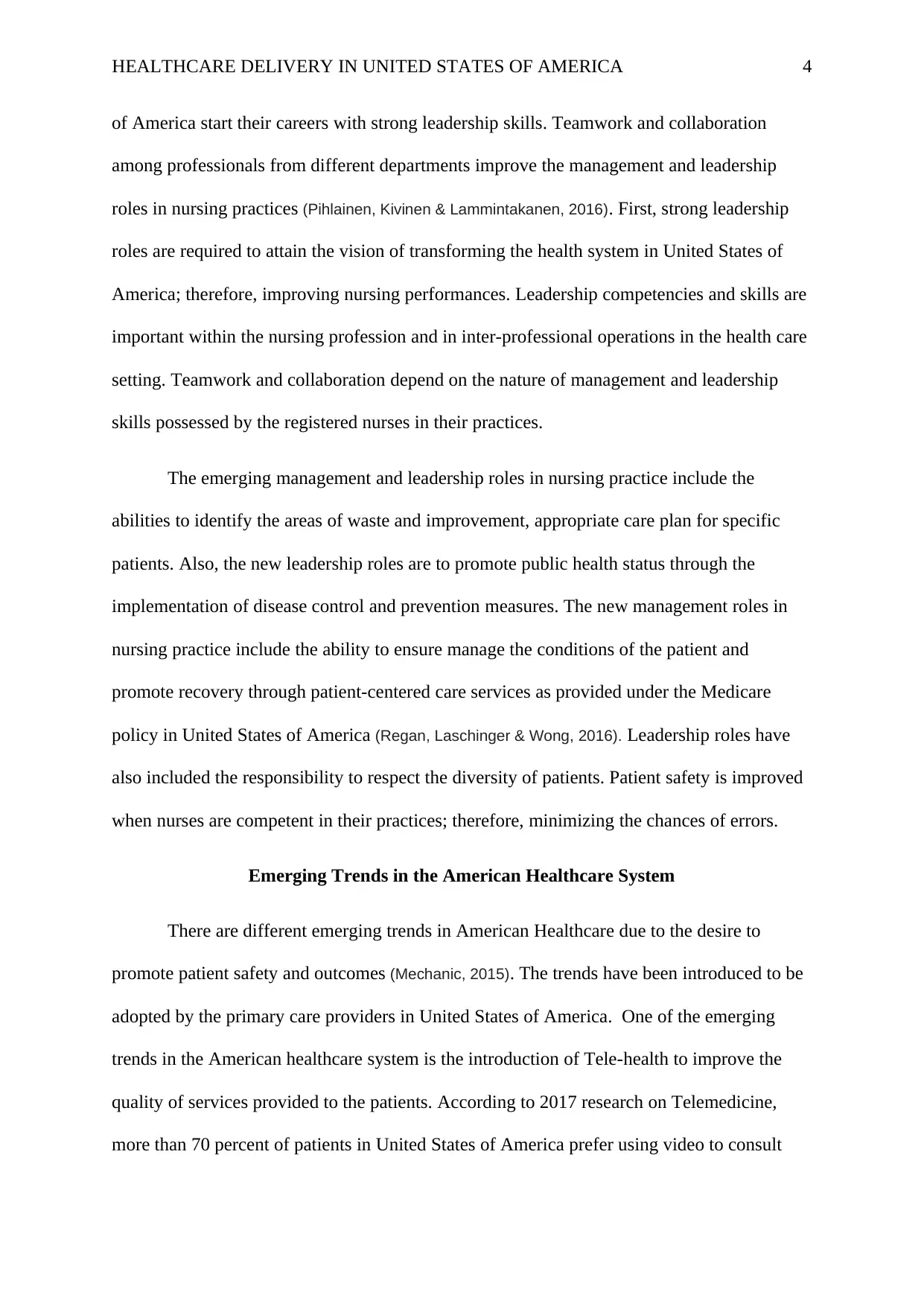
HEALTHCARE DELIVERY IN UNITED STATES OF AMERICA 4
of America start their careers with strong leadership skills. Teamwork and collaboration
among professionals from different departments improve the management and leadership
roles in nursing practices (Pihlainen, Kivinen & Lammintakanen, 2016). First, strong leadership
roles are required to attain the vision of transforming the health system in United States of
America; therefore, improving nursing performances. Leadership competencies and skills are
important within the nursing profession and in inter-professional operations in the health care
setting. Teamwork and collaboration depend on the nature of management and leadership
skills possessed by the registered nurses in their practices.
The emerging management and leadership roles in nursing practice include the
abilities to identify the areas of waste and improvement, appropriate care plan for specific
patients. Also, the new leadership roles are to promote public health status through the
implementation of disease control and prevention measures. The new management roles in
nursing practice include the ability to ensure manage the conditions of the patient and
promote recovery through patient-centered care services as provided under the Medicare
policy in United States of America (Regan, Laschinger & Wong, 2016). Leadership roles have
also included the responsibility to respect the diversity of patients. Patient safety is improved
when nurses are competent in their practices; therefore, minimizing the chances of errors.
Emerging Trends in the American Healthcare System
There are different emerging trends in American Healthcare due to the desire to
promote patient safety and outcomes (Mechanic, 2015). The trends have been introduced to be
adopted by the primary care providers in United States of America. One of the emerging
trends in the American healthcare system is the introduction of Tele-health to improve the
quality of services provided to the patients. According to 2017 research on Telemedicine,
more than 70 percent of patients in United States of America prefer using video to consult
of America start their careers with strong leadership skills. Teamwork and collaboration
among professionals from different departments improve the management and leadership
roles in nursing practices (Pihlainen, Kivinen & Lammintakanen, 2016). First, strong leadership
roles are required to attain the vision of transforming the health system in United States of
America; therefore, improving nursing performances. Leadership competencies and skills are
important within the nursing profession and in inter-professional operations in the health care
setting. Teamwork and collaboration depend on the nature of management and leadership
skills possessed by the registered nurses in their practices.
The emerging management and leadership roles in nursing practice include the
abilities to identify the areas of waste and improvement, appropriate care plan for specific
patients. Also, the new leadership roles are to promote public health status through the
implementation of disease control and prevention measures. The new management roles in
nursing practice include the ability to ensure manage the conditions of the patient and
promote recovery through patient-centered care services as provided under the Medicare
policy in United States of America (Regan, Laschinger & Wong, 2016). Leadership roles have
also included the responsibility to respect the diversity of patients. Patient safety is improved
when nurses are competent in their practices; therefore, minimizing the chances of errors.
Emerging Trends in the American Healthcare System
There are different emerging trends in American Healthcare due to the desire to
promote patient safety and outcomes (Mechanic, 2015). The trends have been introduced to be
adopted by the primary care providers in United States of America. One of the emerging
trends in the American healthcare system is the introduction of Tele-health to improve the
quality of services provided to the patients. According to 2017 research on Telemedicine,
more than 70 percent of patients in United States of America prefer using video to consult
Paraphrase This Document
Need a fresh take? Get an instant paraphrase of this document with our AI Paraphraser
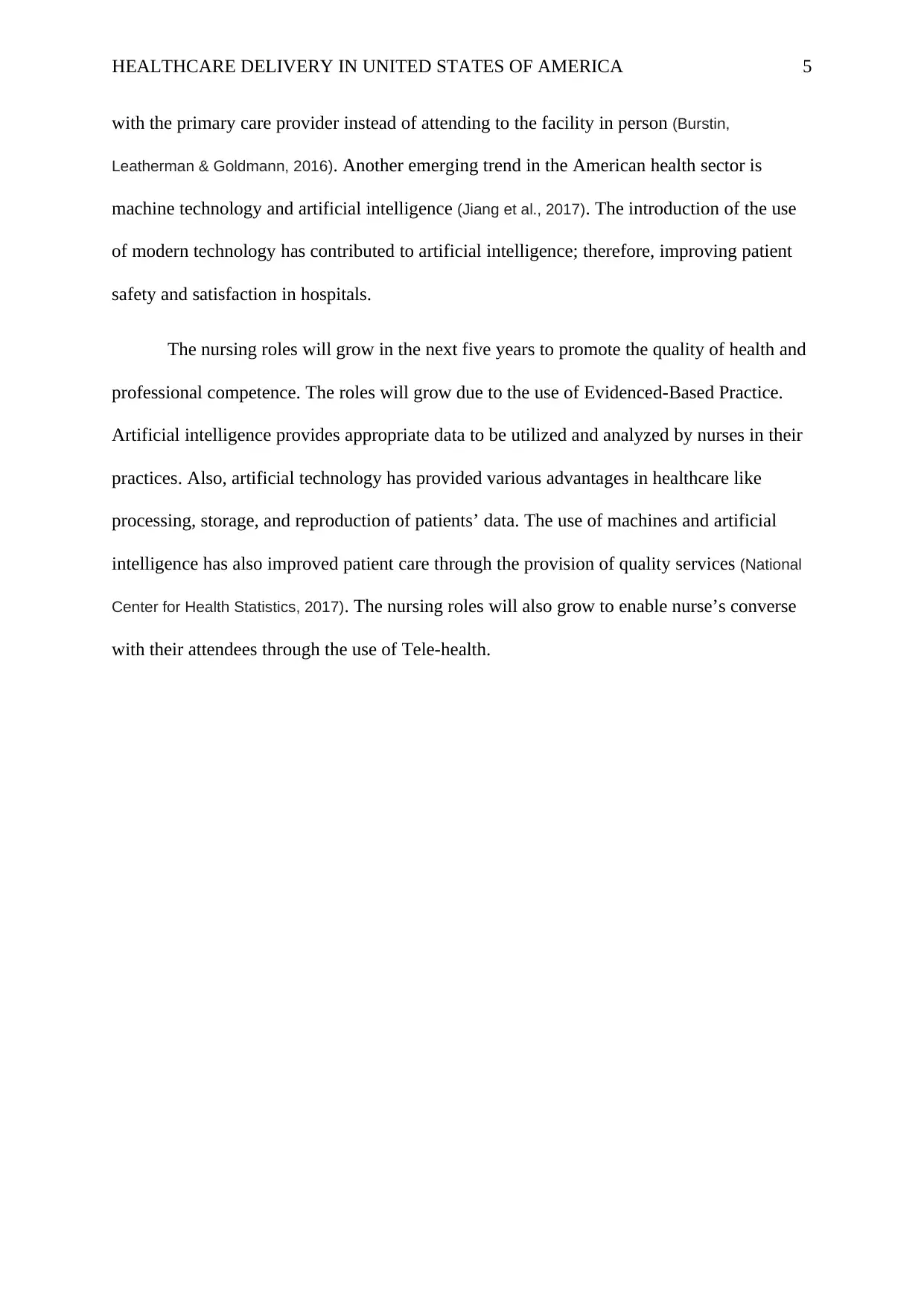
HEALTHCARE DELIVERY IN UNITED STATES OF AMERICA 5
with the primary care provider instead of attending to the facility in person (Burstin,
Leatherman & Goldmann, 2016). Another emerging trend in the American health sector is
machine technology and artificial intelligence (Jiang et al., 2017). The introduction of the use
of modern technology has contributed to artificial intelligence; therefore, improving patient
safety and satisfaction in hospitals.
The nursing roles will grow in the next five years to promote the quality of health and
professional competence. The roles will grow due to the use of Evidenced-Based Practice.
Artificial intelligence provides appropriate data to be utilized and analyzed by nurses in their
practices. Also, artificial technology has provided various advantages in healthcare like
processing, storage, and reproduction of patients’ data. The use of machines and artificial
intelligence has also improved patient care through the provision of quality services (National
Center for Health Statistics, 2017). The nursing roles will also grow to enable nurse’s converse
with their attendees through the use of Tele-health.
with the primary care provider instead of attending to the facility in person (Burstin,
Leatherman & Goldmann, 2016). Another emerging trend in the American health sector is
machine technology and artificial intelligence (Jiang et al., 2017). The introduction of the use
of modern technology has contributed to artificial intelligence; therefore, improving patient
safety and satisfaction in hospitals.
The nursing roles will grow in the next five years to promote the quality of health and
professional competence. The roles will grow due to the use of Evidenced-Based Practice.
Artificial intelligence provides appropriate data to be utilized and analyzed by nurses in their
practices. Also, artificial technology has provided various advantages in healthcare like
processing, storage, and reproduction of patients’ data. The use of machines and artificial
intelligence has also improved patient care through the provision of quality services (National
Center for Health Statistics, 2017). The nursing roles will also grow to enable nurse’s converse
with their attendees through the use of Tele-health.
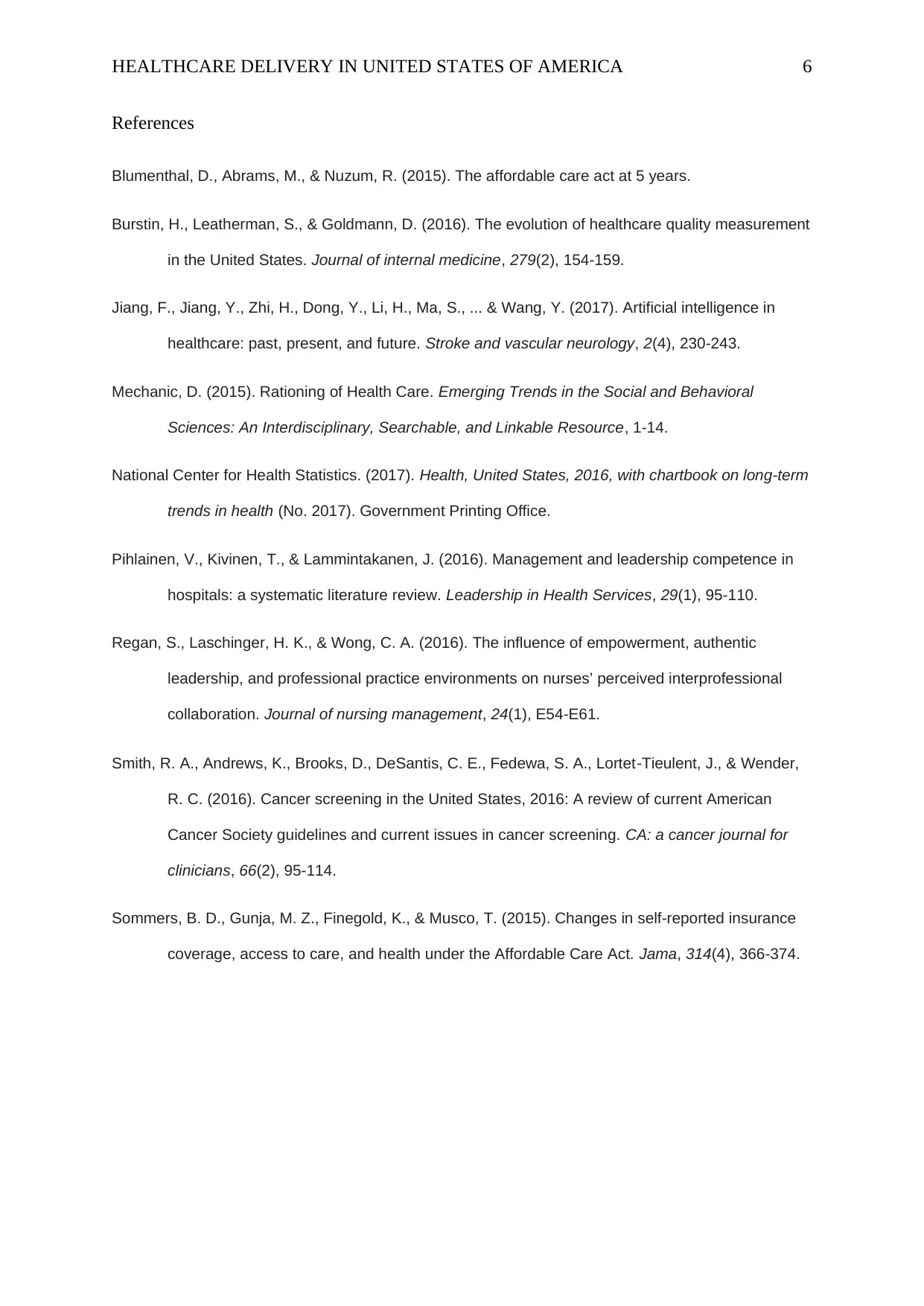
HEALTHCARE DELIVERY IN UNITED STATES OF AMERICA 6
References
Blumenthal, D., Abrams, M., & Nuzum, R. (2015). The affordable care act at 5 years.
Burstin, H., Leatherman, S., & Goldmann, D. (2016). The evolution of healthcare quality measurement
in the United States. Journal of internal medicine, 279(2), 154-159.
Jiang, F., Jiang, Y., Zhi, H., Dong, Y., Li, H., Ma, S., ... & Wang, Y. (2017). Artificial intelligence in
healthcare: past, present, and future. Stroke and vascular neurology, 2(4), 230-243.
Mechanic, D. (2015). Rationing of Health Care. Emerging Trends in the Social and Behavioral
Sciences: An Interdisciplinary, Searchable, and Linkable Resource, 1-14.
National Center for Health Statistics. (2017). Health, United States, 2016, with chartbook on long-term
trends in health (No. 2017). Government Printing Office.
Pihlainen, V., Kivinen, T., & Lammintakanen, J. (2016). Management and leadership competence in
hospitals: a systematic literature review. Leadership in Health Services, 29(1), 95-110.
Regan, S., Laschinger, H. K., & Wong, C. A. (2016). The influence of empowerment, authentic
leadership, and professional practice environments on nurses’ perceived interprofessional
collaboration. Journal of nursing management, 24(1), E54-E61.
Smith, R. A., Andrews, K., Brooks, D., DeSantis, C. E., Fedewa, S. A., Lortet‐Tieulent, J., & Wender,
R. C. (2016). Cancer screening in the United States, 2016: A review of current American
Cancer Society guidelines and current issues in cancer screening. CA: a cancer journal for
clinicians, 66(2), 95-114.
Sommers, B. D., Gunja, M. Z., Finegold, K., & Musco, T. (2015). Changes in self-reported insurance
coverage, access to care, and health under the Affordable Care Act. Jama, 314(4), 366-374.
References
Blumenthal, D., Abrams, M., & Nuzum, R. (2015). The affordable care act at 5 years.
Burstin, H., Leatherman, S., & Goldmann, D. (2016). The evolution of healthcare quality measurement
in the United States. Journal of internal medicine, 279(2), 154-159.
Jiang, F., Jiang, Y., Zhi, H., Dong, Y., Li, H., Ma, S., ... & Wang, Y. (2017). Artificial intelligence in
healthcare: past, present, and future. Stroke and vascular neurology, 2(4), 230-243.
Mechanic, D. (2015). Rationing of Health Care. Emerging Trends in the Social and Behavioral
Sciences: An Interdisciplinary, Searchable, and Linkable Resource, 1-14.
National Center for Health Statistics. (2017). Health, United States, 2016, with chartbook on long-term
trends in health (No. 2017). Government Printing Office.
Pihlainen, V., Kivinen, T., & Lammintakanen, J. (2016). Management and leadership competence in
hospitals: a systematic literature review. Leadership in Health Services, 29(1), 95-110.
Regan, S., Laschinger, H. K., & Wong, C. A. (2016). The influence of empowerment, authentic
leadership, and professional practice environments on nurses’ perceived interprofessional
collaboration. Journal of nursing management, 24(1), E54-E61.
Smith, R. A., Andrews, K., Brooks, D., DeSantis, C. E., Fedewa, S. A., Lortet‐Tieulent, J., & Wender,
R. C. (2016). Cancer screening in the United States, 2016: A review of current American
Cancer Society guidelines and current issues in cancer screening. CA: a cancer journal for
clinicians, 66(2), 95-114.
Sommers, B. D., Gunja, M. Z., Finegold, K., & Musco, T. (2015). Changes in self-reported insurance
coverage, access to care, and health under the Affordable Care Act. Jama, 314(4), 366-374.
⊘ This is a preview!⊘
Do you want full access?
Subscribe today to unlock all pages.

Trusted by 1+ million students worldwide
1 out of 6
Related Documents
Your All-in-One AI-Powered Toolkit for Academic Success.
+13062052269
info@desklib.com
Available 24*7 on WhatsApp / Email
![[object Object]](/_next/static/media/star-bottom.7253800d.svg)
Unlock your academic potential
Copyright © 2020–2025 A2Z Services. All Rights Reserved. Developed and managed by ZUCOL.





